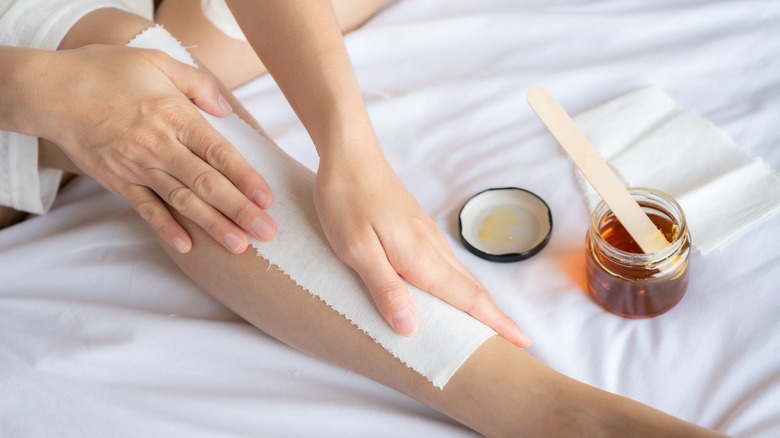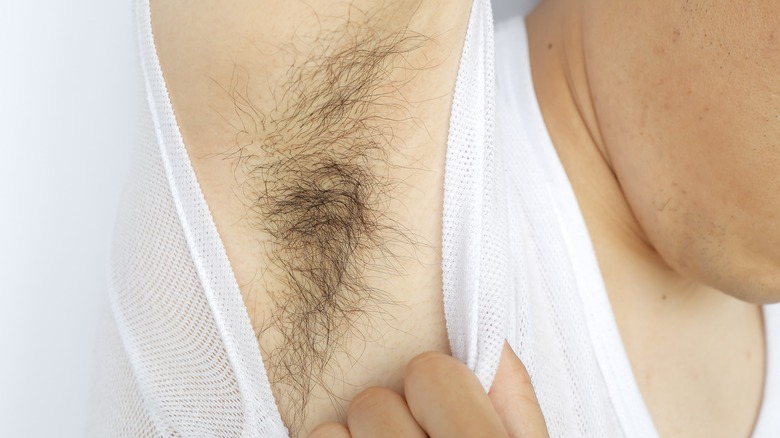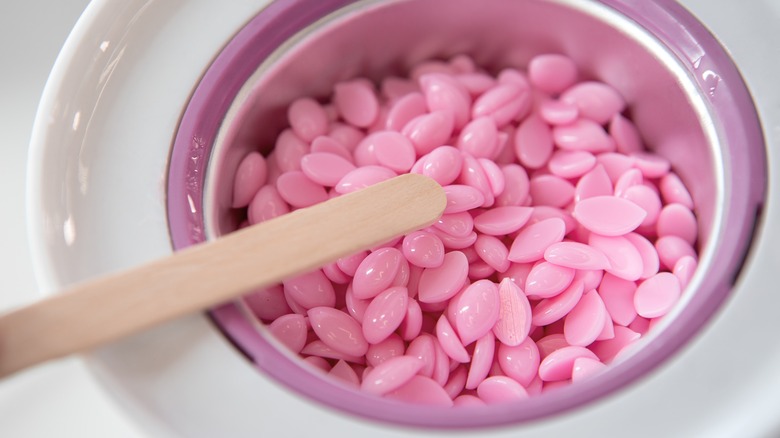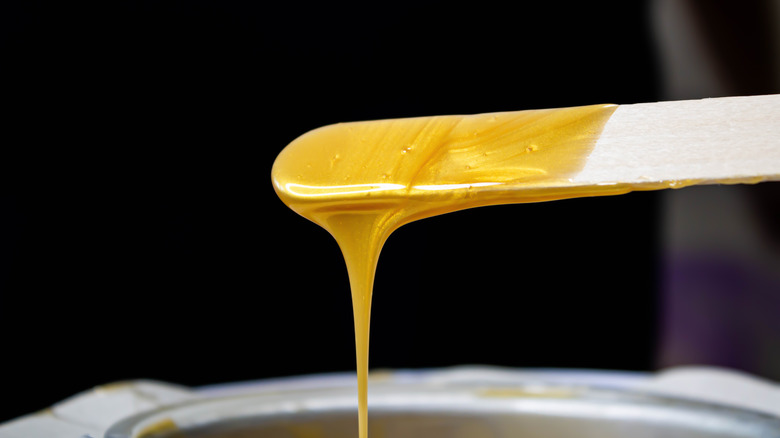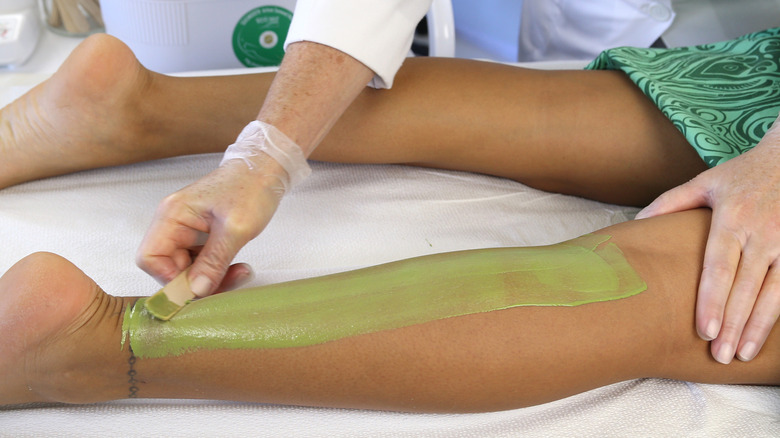5 Reasons Why Your At-Home Waxing Sesh Isn't Removing All The Hair
Over the past couple of years, we've grown accustomed to doing a lot of things at home, and that includes waxing. When hitting the salon is not an option, at-home waxing kits provide an easy, convenient way to remove unwanted hair without the hassle of shaving. Whether you want to admit it or not, it's pretty satisfying to see that layer of hair on your wax strip after pulling it off. But are your waxing sessions leaving you unsatisfied?
It's frustrating when the wax isn't doing the one job it's supposed to do — removing all the hair. There are several explanations for this. Waxing can be tricky, especially when you're doing it by yourself. Not everyone is a professionally trained esthetician, but knowing what you're doing wrong can save you the headache (and skin burn) of improper waxing. We're here to share a few reasons why your wax may not be giving you the silky, smooth feeling you desire.
You didn't cleanse your skin first
Prepping your skin for waxing is the first vital step in the hair removal process. Just as you should wash your face before applying makeup, you should cleanse your skin before waxing. When there's excess oil on the skin and hair, the wax does not adhere to the skin properly. It's also a great idea to exfoliate before you wax to scrub away dead skin cells. This will make it easier for the wax to stick to your hair as well as loosen ingrown hairs, according to Healthline.
Some waxing kits come with a pre-wax cleanser and oil-absorbing powders. Brands like Starpil have a variety of products specifically made for use before waxing, but any mild skin cleanser that works for you will suffice. Be sure to dry your skin after cleansing, as the wax cannot adhere to wet skin or hair. Once your skin is clean and dry, you'll be good to go.
Your hair is too short or long
When you see unwanted hair growing in, it's tempting to wax it immediately, but it's important to make sure you have the appropriate hair length for waxing. If your hair is too short, the wax will not adhere properly. Let your hair grow a little longer before waxing to achieve the results you want. However, don't let it get too long before waxing, either. Trying to wax hair that's too long can leave your skin irritated and cause the hair to break rather than be fully removed.
Waxing can be a bit painful, so you don't want to find yourself trying to wax the same area over and over with no success. Trim down hair that is too long to a length long enough to grab hold of the wax. The American Academy of Dermatology recommends that your hair should be between ¼-¾ of an inch before waxing.
You're using the wrong type of wax
How you wax your legs is not the same as how you wax your bikini line. The type of wax you use depends on where you want to wax, so if you're using the wrong one, that may explain why the wax isn't removing all your hair. There are several different wax options out there, so it can be tricky to know which one to use.
To break it down, the most common are hard and soft wax, which both require a wax heater. Hard wax is thicker and hardens on your skin for you to remove swiftly with your hands. No wax strip is required. For areas like the bikini line, underarms, and eyebrows, hard wax is your friend. Soft wax spreads more easily on the skin, making it more effective on larger parts of the body, like the arms, legs, and back. It requires a waxing strip that you place over the wax and apply pressure to before ripping it off. Pre-made wax strips are another option if you want a quick and easy wax method that requires little cleanup. These are more effective on areas where hair is sparse, like the belly, and are not always optimal for coarse hair. There is also sugar wax, which is best suited for those with sensitive skin and can be used on any part of the body.
Your wax consistency is off
Heating your wax can be intimidating, but once you have it right, you'll be waxing with ease. Depending on the brand of wax you use, most wax packages will have a temperature guide. Hard and soft waxes are applied at different temperatures, but the exact temperature isn't as important as the consistency. Wax that isn't heated up enough will be too thick and chunky to apply to the skin. This will make it difficult to apply an even layer of wax. If the wax is too hot, the consistency will be too thin and runny. Plus, you'll risk burning your skin. This can cause skin lifting (also called wax burn), where the top layer of skin is pulled away and left open to bacteria, scarring, and pigmentation.
Once your wax has melted, stir it and see how it drips from your waxing stick. If it looks like liquid honey, it has the right consistency. Try applying a small amount of wax to the inside of your wrist to test the temperature. It should feel warm, but it shouldn't hurt or burn. Having the right consistency will allow you to apply the wax correctly and remove the hair effectively.
You're applying and removing your wax incorrectly
Waxing works by removing hair at the root. To do this, you'll need to apply your wax in the direction of hair growth and then swiftly remove the wax in the opposite direction. Depending on the area of your body, hair grows in different directions. For example, take the armpits. In this case, wax should be applied upward at the top part of the underarm and downward at the bottom part. Pay attention to the direction of hair growth. This will tell you which way to apply your wax.
The way you remove the wax is another crucial step to removing all the hair. Once the wax is ready, it should be removed in one quick motion, almost like ripping off a band-aid. Ripping it slowly will not only be super painful, but it will not remove the hair as effectively. Use both hands to remove the wax: one hand to hold the skin taut and the other to quickly pull the wax off in the opposite direction of hair growth. If you are new to waxing, do a patch test on a small area of hair to get the technique down.
